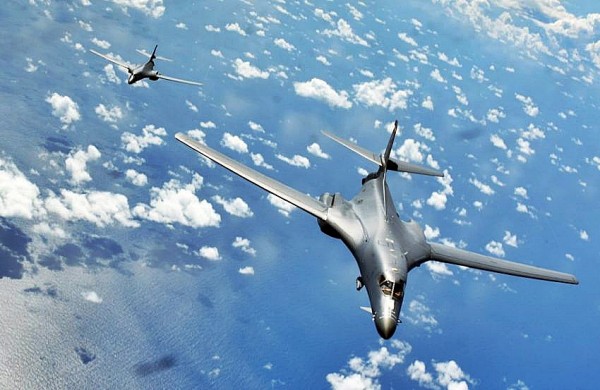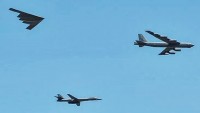Bolder and More Provocative: US Navy and Air Force Conduct First Joint Patrol of South China Sea
| Arthur Dominic Villasanta | | Jun 09, 2017 09:30 PM EDT |
(Photo : USAF) Two U.S. Air Force B-1B Lancer bombers fly over the Pacific Ocean.
(Photo : US Navy) USS Sterett.
The United States conducted its first "joint training mission" over the South China Sea involving a coordinated patrol by two Rockwell B-1B Lancer strategic heavy bombers of the U.S. Air Force and the USS Sterett (DDG-104), an Arleigh Burke-class guided missile destroyer of the United States Third Fleet.
Like Us on Facebook
The B-1B bombers, which can carry the heaviest bomb load of all three air force strategic heavy bombers, flew a 10-hour mission from their base at Andersen Air Force Base on Guam. They flew through the airspace above the South China Sea in an operation coordinated with the USS Sterett.
This mission is the first joint air-sea mission by the air force and navy and plays to the U.S. strength in combined arms operations.
The joint training was organized under the "Continuous Bomber Presence" (CBP) program of the United States Pacific Command (USPACOM) being implemented from Andersen. The program seeks to bolster interoperability between the navy and air force "by refining joint tactics, techniques and procedures while simultaneously strengthening their ability to seamlessly integrate their operations."
The B-1Bs are assigned to the 9th Expeditionary Bomb Squadron, deployed from Dyess Air Force Base, Texas to Andersen.
The B-1B Lancers have been supporting USPACOM's CBP mission since Aug. 6, 2016 when the first B-1s from the 28th Bomb Wing out of Ellsworth Air Force Base, South Dakota deployed to Guam for the first time in a decade.
This joint patrol also means more joint patrols are forthcoming. These coordinated patrols will see air force bombers fly overhead "cover" for destroyers conducting Freedom of Navigation Operation Patrols (FONOPS) that sail closer to China's three largest man-made and militarized islands in the South China Sea: Fiery Cross Reef; Subi Reef and Mischief Reef, all of which are also claimed by the Philippines, Taiwan and Vietnam.
U.S. Navy patrols of the South China Sea are becoming increasingly bolder.
Last May 25, the Arleigh Burke-class destroyer USS Dewey (DDG-105) sailed to within 12 nautical miles of Mischief Reef (Panganiban Reef to Filipinos) located in the Spratly Islands some 250 west of Palawan Island in The Philippines.
Mischief Reef, which for centuries was part of the Philippines, was illegally seized by China in 1995. China has since built a military base with a large harbor and a 2.6 km-long airstrip on the reef, and reclaimed land covering 5.58 km2.
The navy said the USS Dewey carried out a "maneuvering drill" when it sailed within 12 nautical miles of Mischief Reef to show China it isn't entitled to a territorial sea around it, said U.S. officials.
The operation near Mischief Reef was the boldest U.S. challenge yet to Chinese island-building in the strategic waterway -- and apparently indicates the Trump administration's willingness to use military force against China.
Both the Sterett and Dewey were together deployed to Asia last March. These destroyers comprise the Surface Action Group of the U.S. Third Fleet, which is now operating in Asia.
TagsUnited States, joint training mission, South China Sea, Rockwell B-1B Lancer, USS Sterett (DDG 104), Andersen Air Force Base, Guam
©2015 Chinatopix All rights reserved. Do not reproduce without permission
EDITOR'S PICKS
-

Did the Trump administration just announce plans for a trade war with ‘hostile’ China and Russia?
-

US Senate passes Taiwan travel bill slammed by China
-

As Yan Sihong’s family grieves, here are other Chinese students who went missing abroad. Some have never been found
-

Beijing blasts Western critics who ‘smear China’ with the term sharp power
-

China Envoy Seeks to Defuse Tensions With U.S. as a Trade War Brews
-

Singapore's Deputy PM Provides Bitcoin Vote of Confidence Amid China's Blanket Bans
-

China warns investors over risks in overseas virtual currency trading
-

Chinese government most trustworthy: survey
-

Kashima Antlers On Course For Back-To-Back Titles
MOST POPULAR
LATEST NEWS
Zhou Yongkang: China's Former Security Chief Sentenced to Life in Prison

China's former Chief of the Ministry of Public Security, Zhou Yongkang, has been given a life sentence after he was found guilty of abusing his office, bribery and deliberately ... Full Article
TRENDING STORY

China Pork Prices Expected to Stabilize As The Supplies Recover

Elephone P9000 Smartphone is now on Sale on Amazon India

There's a Big Chance Cliffhangers Won't Still Be Resolved When Grey's Anatomy Season 13 Returns

Supreme Court Ruled on Samsung vs Apple Dispute for Patent Infringement

Microsoft Surface Pro 5 Rumors and Release Date: What is the Latest?













